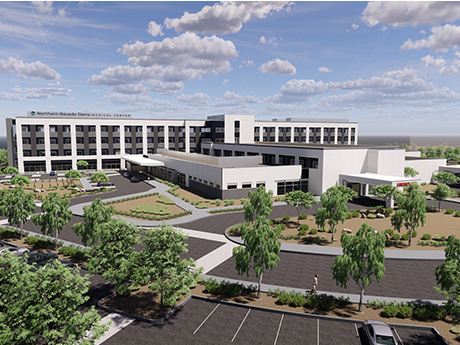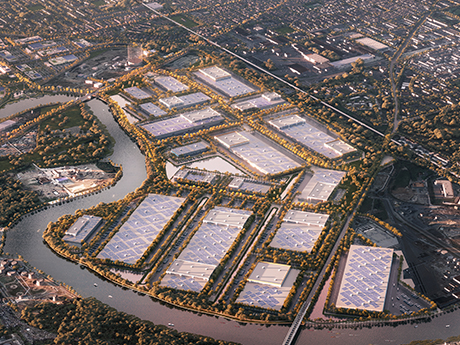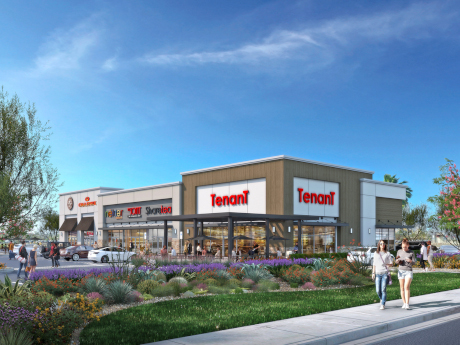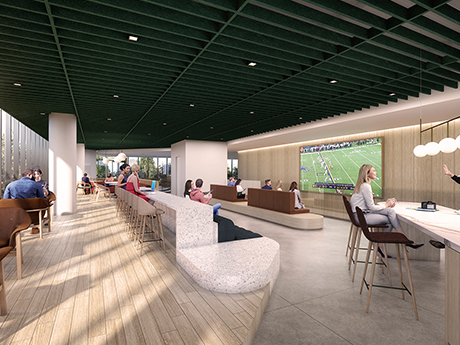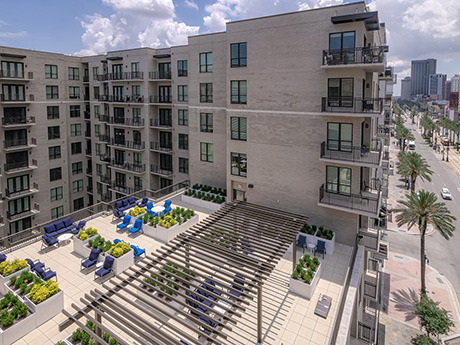By Nick Knecht, Senior Advisor, Industrial, Dickson Commercial Group The vibrancy and growth of the Reno-Sparks industrial market has solidified the region’s position as a premier distribution hub of the Western U.S. — even as we head into what is expected to be a nationwide economic slowdown in the near term. The third quarter continued the trend of positive net absorption of 469,970 square feet. This occurred even with four new construction deliveries totaling 1.7 million square feet, 98 percent of which was spoken for upon completion. This momentum is expected to continue to some degree, as our team is actively negotiating RFPs on each of our speculative big box listings, with space requirement inquiries coming in at a steady pace. Alongside this positive activity, our market has been affected by the economic turmoil that has started to take shape over the past two quarters, with similar trends discussed nationwide. A changing debt market has produced several price adjustments mid-transaction for buyers to stay within their underwriting thresholds. The number of developers aggressively acquiring land at a feverish pace has decreased as they face a higher cost of capital and tamp down rent growth assumptions to more reasonable levels. There …
Market Reports
By Taylor Williams The New York City retail market is currently functioning like an episode of The Price Is Right. Developers, investors, brokers and operators are all trying to attach fair values to rents and sales prices for spaces of all sizes and submarkets. But after a tumultuous period marked by a global pandemic and record inflation, followed by a string of severe interest rate hikes, accurately assigning those numbers is easier said than done — at least in some submarkets. According to data from JLL, at the end of the third quarter, the average rent throughout New York City was $290 per square foot, down 5.3 percent year over year. That figure represents an improvement from the second quarter of 2022, when rents posted a 12 percent decline on a year-over-year basis. In addition, JLL’s data shows that 58 new leases were signed in the third quarter. While that figure marks a decline of 13 percent from the second quarter, it also constitutes an increase of 7.4 percent on a year-over-year basis. These numbers suggest that after retail leasing and sales completely stagnated in 2020 due to an unprecedented public health crisis, the market corrected sharply in 2021 and …
By Rick John, Executive Vice President, Ontario Branch Manager, DAUM Commercial The San Bernardino industrial market is experiencing strong market fundamentals as it’s home to 18 percent of the Inland Empire East’s nearly 245 million square feet of industrial space. The city also commands one of the highest prices per square foot across the market, exceeding $300. Although vacancy rates for the Inland Empire East increased for the first time since the pandemic – jumping 14 basis points and ending at 1.1 percent for the third quarter – overall vacancy in San Bernardino remains historically low. In fact, it’s among the lowest in the region at 0.24 percent. This incremental increase in vacancies was primarily seen among smaller buildings, while larger buildings of 500,000 square feet or more continue to be in short supply as vacancy remains near zero. Consistent low vacancy and competition for space are encouraging large companies to pre-lease new developments in the construction pipeline. This has helped bring gross leasing activity to near pre-pandemic levels. In September, Shein signed the largest lease within the Riverside-San Bernardino metro for the quarter with plans to open a 1.8-million-square-foot distribution center that’s currently under development in Cherry Valley. Due …
By Melissa Molyneaux, Executive Vice President, Colliers Northern Nevada’s office market has continued to post strong fundamentals this year. Positive tenant demand has improved vacancy in recent quarters, though an uptick in available sublease space could impact market-wide vacancy in the future. The Reno-Sparks region has also seen a handful of new speculative office construction starts that will add trophy office and medical office space to the downtown and South Meadows submarkets. Strong economic recovery has been evident this year as Nevada reached a new employment peak of nearly 1.5 million jobs in June. Washoe County’s population has grown an impressive 17.1 percent since 2010, to 500,000 people. A study by Woods and Poole Economics estimates the area will reach 764,000 people by 2060. Market-wide vacancy rates dropped to 10.6 percent in the third quarter of 2022, down 200 basis points year over year. Downtown vacancy fell 310 basis points to 11.7 percent, while suburban vacancy fell 180 basis points to 10.3 percent in the same period. Vacancy has continued to improve since the onset of the pandemic, though the Reno area has started to see an increase in available sublease space hitting the market. About one quarter of all …
By Andrew Chused, founding partner, head of investments, Hilco Redevelopment Partners From the nation’s beginning to modern times, Philadelphia has been a bellwether city with a proud legacy of leading the nation to many of its firsts, including the country’s inaugural medical school, library, hospital, business school and stock exchange. In this city of firsts, Hilco Redevelopment Partners (HRP) is unlocking and reinventing a large portion of the city: the former 1,300-acre Philadelphia Energy Solutions (PES) site on the city’s southwest side. Not only is the redevelopment of this site transforming a relic of the city’s industrial age into a new, sustainable economy for the first time, but the project will also transform the way logistics and life sciences companies grow in southwest Philadelphia. An Economic Hub The site, aptly named The Bellwether District, represents a new ecosystem for a variety of tenants, including logistics, e-commerce and life sciences. Located in the shadows of University City and along the Schuylkill River, the project will create over 32,000 jobs and serve as an economic catalyst that drives growth to the city and region for generations to come. Upon its acquisition of the property in June of 2020, HRP quickly began the …
By Ryan Gast, Vice President, Ontario/Inland Empire, CBRE We are currently seeing a very strong leasing market in San Bernardino County, which is mostly driven by the amount of new housing developments in the market and the lack of new retail product being built. Tenants are hungry for the top-tier shopping centers, which has driven the vacancy rates down and rents up in a market where there seems to be a lot of uncertainty in the air. Some of the most active retail categories include the fast feeders (QSRs), gas stations and car wash groups. Discount retailers also hold great appeal, particularly due to inflation. The market has also seen an increase in activity from fitness users who stopped dead in their tracks during 2020 and 2021 due to COVID. As active retailers go, Stater Bros, Hobby Lobby, Burlington, 99 Ranch Market, Ross and Planet Fitness have all recently inked deals in the area. Sprouts, Quick Quack, Shell, Raising Cane’s and Dutch Bros Coffee also remain active. Many of these retailers are seeking high-growth areas where there has been an influx of residential development nearby. In terms of developers, Lewis Retail, Wood Investments and Rich Development are some of the …
By Taylor Williams Success in today’s office sector is all about creating incentives. Some companies, from small professional services outfits to tech giants like Salesforce and Airbnb, have completely capitulated to remote work and have aggressively slashed their office footprints. Others remain dogged in their commitments to nonresidential (and nonretail) workspaces. What works for one company may not work for its competitors, and there remains a fundamental need for at least some traditional office space across all major markets. Against this backdrop, what separates the winners from the losers is the ability to create a draw, to give people legitimately good reasons to get up earlier, spend more time getting ready, endure traffic, put costly mileage on their cars, then deal with whatever quirky goings-on define their office experience. Needless to say, this can be a tough sell, especially for employees with families and suburban commutes. Which is why owners, both of businesses and of the office buildings that house them, are getting creative. These corporate leaders and landlords are working in tandem to ensure that the spaces meet the precise needs of their workforces, from design and layout within the suite to access to onsite amenities and surrounding retail, …
Increased interest rates and challenging insurance costs would normally stifle a multifamily market. However, an inventory constrained by a lack of land, supply chain issues, labor shortages and the increased cost of homeownership have contributed to a further stabilization of the metro New Orleans multifamily market. The overall vacancy factor for our seven primary submarkets that make up metro New Orleans are in the 5 to 6 percent range. We anticipate occupancy rates to steadily increase going forward as new construction has stalled and rising interest rates have delayed many tenants from transitioning to homeownership. Overall rental rates in the metro average in the $1,250 to $1,350 per month range. The rents represent a 3.5 percent increase over the past 12 months. It should be noted that some submarkets have seen considerably higher increases. The highest rental rates reported in the metro for garden-style communities are in Eastern St. Tammany Parish, where the newest inventory exists. The highest rents in New Orleans are downtown in the CBD/Warehouse District. These communities comprise mid-rise and high-rise developments and command rents exceeding $2.50 per square foot. The downtown market experienced some softness during the COVID-19 pandemic but made a robust recovery once restrictions …
By Steve Roppel, Senior Vice President, Allied Commercial Real Estate Encompassing 62 square miles, San Bernardino is the governmental seat of San Bernardino County, the largest county in the world at more than 21,000 square miles. About 86,000 people alone work within the city, per the 2020 Census. The largest industries are retail (12,280 people), transportation and warehousing (11,164 people) and health (9,603 people). Of the six largest office buildings, only one is occupied by traditional multiple commercial tenants. The others are occupied by the county, city, courts, non-profits and the University of Loma Linda. The only large office building presently proposed is a county office building of 307,000 square feet. San Bernardino was historically a vibrant metropolitan whose image has become tarnished over the years. It is famous for its affiliation with Route 66, which runs through the city and allowed many people to emigrate to the Golden State. The first original McDonald’s restaurant – now a museum – was opened in San Bernardino in 1940. To restore the former luster and recognize the potential for San Bernardino, local governments have pulled together on several fronts. Multiple recent infrastructure improvements and redevelopments were completed and planned for San Bernardino, …
By Jason Baker of Baker Katz It’s amazing how quickly things can change. Just a few short months ago, the commercial real estate outlook was generally positive. Both in Texas and nationally, retail sales were proving to be fairly resilient to the rising inflation and economic turbulence that have characterized most of 2022. Despite low consumer confidence, strong fundamentals and a retail sector riding the high of a post-pandemic boom provided plenty of reasons for optimism. That has all changed in the last 60 to 90 days. Prevailing positivity has recently given way to concern, and sentiment from within the industry has clearly shifted. High interest rates have made it virtually impossible to develop any type of commercial project, and persistent supply chain constraints and ongoing hikes in costs of construction materials have further exacerbated this challenge. With interest rate increases come higher cap rates, which complicates sellers’ efforts to move their assets while values are this fluid. To put the impact of rising rates into perspective, interest payments on commercial real estate have in some cases increased five-fold in just the last few months. The impact of this activity on retail real estate during the all-important holiday shopping season …





